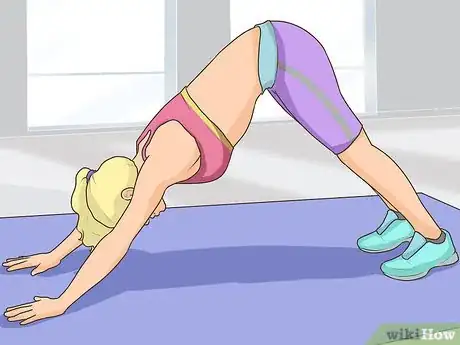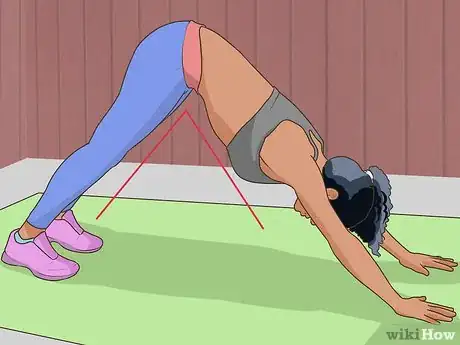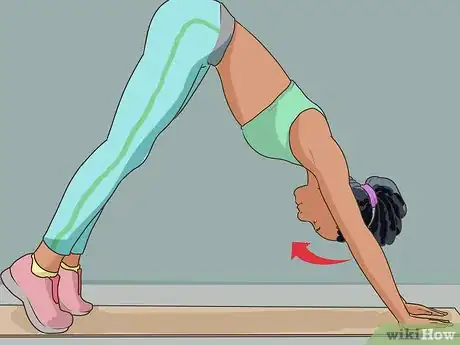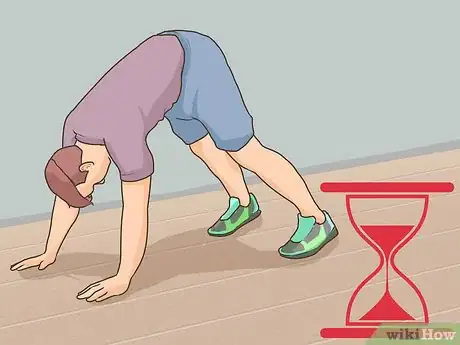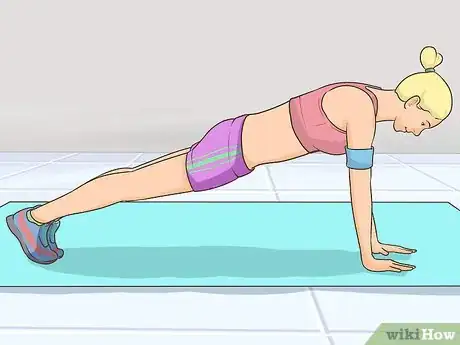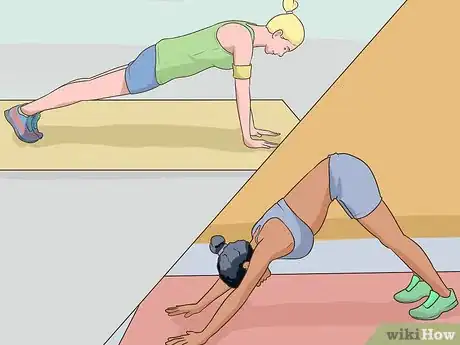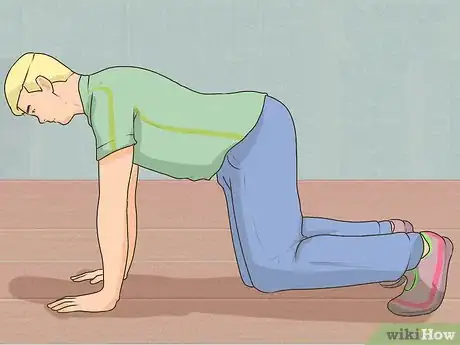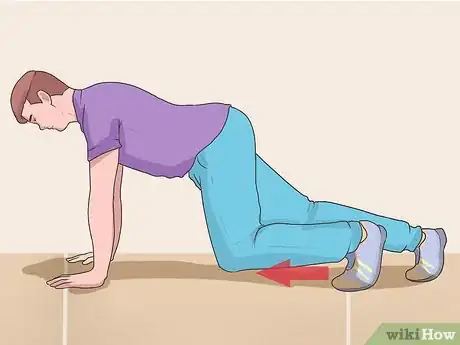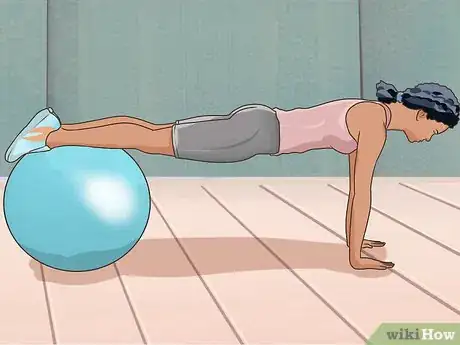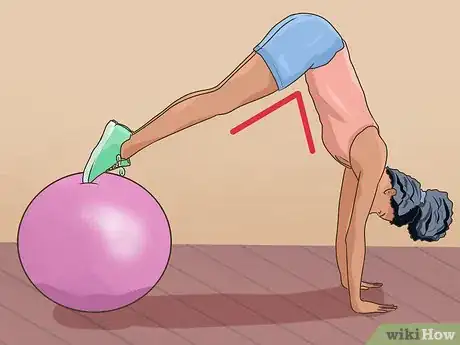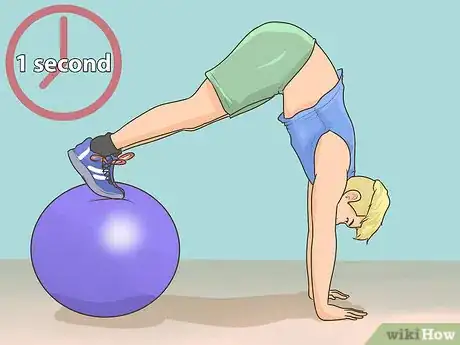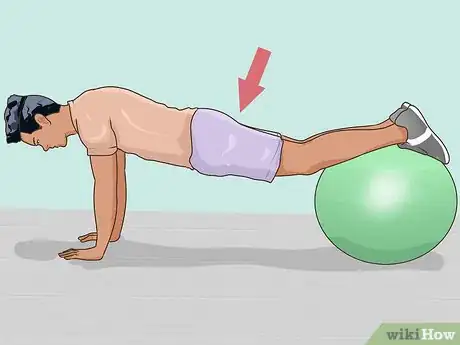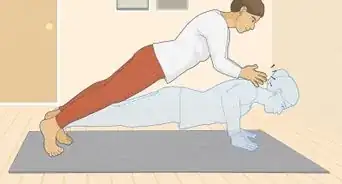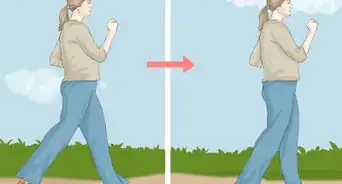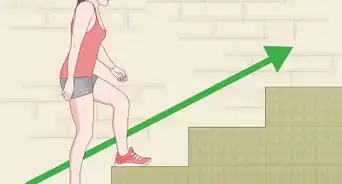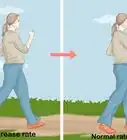This article was co-authored by Steve Bergeron. Steve Bergeron is a Personal Trainer, Strength Coach, and the Co-Owner of AMP Fitness in Boston, Massachusetts. With over a decade of experience, Steve specializes in educating, guiding, and empowering his clients to develop healthy habits and reach their individual fitness goals. He holds a BS in Exercise Physiology and is an NSCA Certified Strength and Conditioning Coach (CSCS), ASCM Health and Fitness Specialist (HFS), Strong First Kettlebell Coach (SFG), and Certified Functional Movement Screen Specialist (FMS). AMP Fitness’ mission is to create a community that is inclusive and gives people the tools and support they need to succeed.
There are 8 references cited in this article, which can be found at the bottom of the page.
This article has been viewed 146,218 times.
Pike-ups are a quick but fairly challenging exercise that will engage multiple muscle groups. On top of that, you don't need equipment or a gym membership to do the exercise since it's based on body-weight, though if you want to really challenge yourself (especially your core), adding a Swiss ball will intensify the workout and improve results.
Steps
Assuming the Proper Position
-
1Place your palms flat on the floor while kneeling. Ensure the palms are aligned directly under the shoulders. If hand placement is too wide or narrow, you’ll be engaging other muscles too much and minimizing not only the stability, but also the effect on the muscles being worked by the pike up.[1]
-
2Move into a plank position by straightening your body. The plank should look like the starting position for a pushup, where your palms are on the ground, arms are straight, and the body (i.e. legs, torso, neck) is aligned. This move will work your abdominal muscles, lower back, triceps, and all major leg muscles.[2] Your body should be entirely straight, from head to toe.[3] This may be difficult at first, and your muscles may fatigue enough to start quivering.[4]Advertisement
-
3Stabilize your body. By pushing your toes into the ground and squeezing the buttocks muscles, the strain is taken off the abs somewhat. Without locking out your knees, tighten your leg muscles. Finally, locate a spot approximately 1 foot in front your hands to ensure proper neck alignment.[5]
Performing the Pike Up
-
1Raise your hips. The initial part of the movement out of the plank should be a matter of weight distribution.[6] As you raise your hips into the pike, which will resemble an inverted-V shape when completed, the weight will shift some from your arms muscles to your leg muscles. Your hips should be as high as possible, with your hamstrings fully extended.
- It is similar in form to the downward facing dog position in yoga, but with less emphasis on stretching and breathing, and more focus on the muscular repetitions.
- Push your palms down flat into the floor to ensure you’re not moving back too far.
- Do not bend your knees.
- You may need to walk your feet in a step or 2 to achieve the inverted-V shape.
- Make sure to keep your back straight for the entire exercise. Do not round it.
-
2Lower your head. While the weight is shifting backward, you should begin lowering your head. If you keep your neck in a static position, there will be a considerable amount of strain on the back of the neck muscles.[7] Once you reach the top of the pike position, you should no longer be looking at the spot in front of your palms. Instead, you should be looking somewhere near the ground directly under your waist.
-
3Hold the pike up position. Depending on your strength and conditioning, even holding the position for a second could be challenging. However, with more practice, you’ll be able to extend the length of time you can hold the pike up. Try holding the position for 1 second to start.
- Ensure the abdominal muscles are being kept tight while moving upward. Otherwise, there may be unnecessary strain on the back or other muscles.[8]
-
4Return to the initial plank position. Slowly straighten your hips back out, keeping your core engaged.[9] Correspond the movement of your neck so that your vision moves forward as you’re straightening out your body. This return to plank is the completion of 1 repetition.
-
5Complete multiple reps. Depending on fitness level, it may be difficult to accomplish more than a few reps. For beginners, do minimal sets with minimal repetitions. Go until you feel some fatigue in the arms, abs, and back. Once you've built up endurance, strive for 3 sets of 10 to 12 reps.
Modifying the Inverted-V Position
-
1Start from your knees. Instead of keeping the full plank position, start on all-fours. Once you start your hip shift backward and upward, straighten your legs at the same time. This will delay the amount of time where pressure and tension are on your core.[10]
-
2Walk your feet forward. If you find the top of the V to be difficult, particularly on the abs, try repositioning your feet. At the top of the V, when you are experiencing the most stress, shuffle your feet forward towards your hands just a few inches at a time. Continue moving forward until you feel like you can hold the V a little easier.
- Moving the feet forward adds extra load to the front of your body, and will increase the weight your shoulders and triceps have to hold steady.[11]
-
3Add in a pushup. Once you’re at the top of the V, make it a bit more difficult by adding a pushup to the process. Instead of a 2-count movement, it will now be a 4-count movement. Raise from the plank into the inverted-V, then bend your elbows and slowly lower your head towards the ground while maintaining the inverted-V angle. The top of the head will get close to the ground; so, be careful. Then engage your triceps and shoulders, pushing back into the inverted-V. Finally, return to the plank position.[12]
Doing a Swiss Ball Pike Up
-
1Get into a raised plank position with a Swiss ball under your feet. A Swiss ball (a.k.a. stability ball, yoga ball, gym ball, or Pilates ball) is an inflatable, rubbery ball that can be used to improve balance and stability. By adding it to the pike up, your upper and lower bodies are forced to work together to stabilize, and all the work comes from the core. This makes it an excellent variation if you're trying to strengthen your abdominals beyond the usual crunches.
- Your toes should be pointed so that the top, or laces, of your sneakers are resting on the ball.[13]
- Keep your back flat and straight — not sagging or rounded. Your arms should be in push-up position, under your shoulders and straight (though not locked).[14]
- Be careful when attempting this exercise. It's extremely challenging and requires balance, and you could harm yourself if your arms give out or you fall off the ball.
-
2Lift your hips into the inverted V-shape. As you raise your hips, the ball will roll forward. Do not roll the ball so far forward that you fall off — your toes should maintain contact with the ball while you are in the pike position.
- Keep your abs very tight, your hips square with the ground.
-
3Hold the position. You may only be able to hold this position for a moment. Start with 1 second and, as you improve, hold for longer. Again, make sure your abs are tight, which will help keep your balance.
-
4Lower your hips and return to the starting position. Using your core for stability, slowly lower your hips back down, rolling the ball backward, until you are in the raised plank position. This return to plank is the completion of 1 repetition.
- You may only be able to do a couple of reps at first. That's okay. Work your way up to doing 8 or 10 reps.
Expert Q&A
-
QuestionHow do I make sure I have the right form?
 Steve BergeronSteve Bergeron is a Personal Trainer, Strength Coach, and the Co-Owner of AMP Fitness in Boston, Massachusetts. With over a decade of experience, Steve specializes in educating, guiding, and empowering his clients to develop healthy habits and reach their individual fitness goals. He holds a BS in Exercise Physiology and is an NSCA Certified Strength and Conditioning Coach (CSCS), ASCM Health and Fitness Specialist (HFS), Strong First Kettlebell Coach (SFG), and Certified Functional Movement Screen Specialist (FMS). AMP Fitness’ mission is to create a community that is inclusive and gives people the tools and support they need to succeed.
Steve BergeronSteve Bergeron is a Personal Trainer, Strength Coach, and the Co-Owner of AMP Fitness in Boston, Massachusetts. With over a decade of experience, Steve specializes in educating, guiding, and empowering his clients to develop healthy habits and reach their individual fitness goals. He holds a BS in Exercise Physiology and is an NSCA Certified Strength and Conditioning Coach (CSCS), ASCM Health and Fitness Specialist (HFS), Strong First Kettlebell Coach (SFG), and Certified Functional Movement Screen Specialist (FMS). AMP Fitness’ mission is to create a community that is inclusive and gives people the tools and support they need to succeed.
Personal Trainer & Strength Coach You want to master both the starting and ending position. That will help you stay in the proper position throughout the exercise. Also, make sure your spine is neutral and you're not arching your back a lot.
You want to master both the starting and ending position. That will help you stay in the proper position throughout the exercise. Also, make sure your spine is neutral and you're not arching your back a lot.
Warnings
- As with any change to an exercise regime, be aware of your current fitness levels and discuss any concerns with your health professional.⧼thumbs_response⧽
- If you have any injuries or you are recovering or have recovered from an injury, check with your health professional before attempting this exercise.⧼thumbs_response⧽
Things You'll Need
- Soft floor surface or a mat
- Comfortable exercise clothing
- Water for hydration
References
- ↑ https://www.youtube.com/watch?v=QurW5ELc4oA
- ↑ http://www.weakbackbuilder.com/blog/plank-exercise-benefits/
- ↑ http://www.realsimple.com/health/fitness-exercise/workouts/circuit-training-workouts/pike-work-out-routine
- ↑ https://www.yahoo.com/beauty/why-your-muscles-shake-during-planks-and-other-104966840807.html
- ↑ http://greatist.com/fitness/perfect-plank
- ↑ http://www.realsimple.com/health/fitness-exercise/workouts/circuit-training-workouts/pike-work-out-routine
- ↑ https://www.youtube.com/watch?v=QurW5ELc4oA
- ↑ https://www.youtube.com/watch?v=QurW5ELc4oA
- ↑ http://www.thepostgame.com/blog/training-day/201105/single-best-ab-exercise-and-its-not-crunch
- ↑ http://www.realsimple.com/health/fitness-exercise/workouts/circuit-training-workouts/pike-work-out-routine
- ↑ http://www.health.com/health/gallery/0,,20542504_3,00.html
- ↑ http://www.realsimple.com/health/fitness-exercise/workouts/circuit-training-workouts/pike-work-out-routine
- ↑ http://www.shape.com/fitness/workouts/master-move-swiss-ball-pike
- ↑ http://www.shape.com/fitness/workouts/master-move-swiss-ball-pike
About This Article
To do pike-ups, start in a basic plank position with your hands flat on the floor directly under your shoulders. Next, shift some of your weight into your leg muscles as you raise your hips into the pike, which resembles an inverted V shape. When your hips are as high as possible, lower your head to avoid any neck strain. Hold the pike position for 1 second to start, then slowly return to the initial plank position to complete 1 repetition. If you’re a beginner, repeat until you feel fatigued, gradually building up to 3 sets of 10 to 12 reps. For more tips from our Fitness co-author, including how to do a pike-up on a Swiss ball, keep reading!


